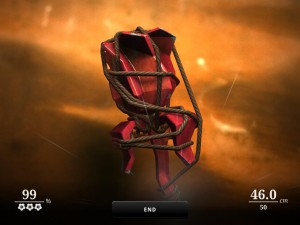Zen Bound 2: A clumsy finish
Rushing through this game is probably not the right way to play it, but that’s what I’ve done, just to free it from the Stack. Since it’s the only game of its kind, it’s reasonably likely that I’ll go back to it at some point, to try to perfect my performance. There’s an Achievement called “Perfection” for 100% completion, and another called “Nirvana” described as “Learn to let go after attaining Perfection”, which I assume means getting 100% completion and then wiping your progress. Although it would be kind of funny, in a cruel way, if it didn’t mean that.
Not that we know for sure right now. Looking at the global stats for Zen Bound 2, it seems that no one has actually achieved Perfection. Or at least, few enough that it rounds down to 0.0% of players. Even the achievement for getting a minimal passing grade on all the levels has been claimed by a mere 0.9%, which is oddly low for something so easy. As a point of comparison, 13.9% of players have got the “Unwinder” achievement, for using up all the rope and then reeling every inch of it back. There is no reason to do this other than for the sake of the achievement. If you want to start a puzzle over, you can just reset it. So 13.9% of the players are achievement-mongers, but only about 6.5% of those people thought it worthwhile to grab the much rarer achievement for finishing the game. What gives?
I don’t think it’s likely that anyone gives up on this game because they’re stuck and unable to make progress, so people must give up on it because it isn’t to their liking. Well, okay, it’s an oddball game. To me, its mere oddballness is appealing, but the reason we see so many games rehash the same ideas is that those are the ideas that a lot of people like. But I think I can identify another reason why people wouldn’t like it: it is a fundamentally awkward game.
I know I spoke in praise of its 3D rotation UI, but that’s just half the story. You control the object pretty perfectly, but you don’t control the rope, or at least not directly. You control the rope by catching it on the object. You spend a lot of time trying to nudge it off corners and into crevices, or angle it so that it doesn’t come off said corners. Sometimes you accidentally tie it off before you intend to. Very often you can’t quite see what you’re doing because the free end of the rope is on the underside. And this is a crucial part of the game’s challenge. The awkwardness of the rope isn’t a flaw in the game, it is the game. And it’s impossible to play without thinking about how much easier this would be in real life, where you could just take the object in one hand and the rope in the other for greater control.
Contrast this to more mainstream games, which often go out of their way to present a fantasy of being more competent than you are in real life. I tend to downplay the role of the fantasy element in games, but I’m not just talking about the fiction, I’m talking about the interface. First-person shooters have auto-aiming. Brawlers execute complicated combos with the press of a few buttons. Guitar Hero simplifies its riffs.
And in the end, what’s the result? I don’t think there can be much disagreement that you’re making the sculptures uglier with your efforts. They start off rather elegant, they end up ruined by a clumsy tangle and, unless you managed 100% coverage, a splotchy and incomplete paint job. The game does its best to pretend that it’s pretty, but it’s like a parent’s praise of an attempt at art by a toddler, which is frankly what your efforts resemble. And that’s ignoring the often-unwelcome symbolism. Many of the sculptures are representational, so there’s a sense that you’re putting animals and people into snares, making their condition worse. I suppose the game is kinder to its subjects than a more conventional game, which would just have you kill them. Still, as in Shadow of the Colossus, your goal is to take things of beauty and ruin them. But at least SotC made it difficult. Here, you wind up with an ugly mess regardless of whether you pass the level or not. Because of your clumsy awkwardness.
 Comments(0)
Comments(0)